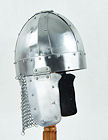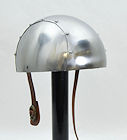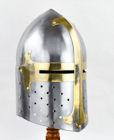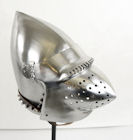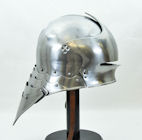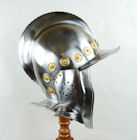 The helmet or helm was developed to keep up with advances in weaponry of the times. Helmet history is fascinating, and chronologically speaking, the helmet is innovation itself. Hickory Arms offers a changing variety of historical and reproduction helmets for you to choose. All the helmets on our website can be worn, and many are functional battle ready helmets.
The helmet or helm was developed to keep up with advances in weaponry of the times. Helmet history is fascinating, and chronologically speaking, the helmet is innovation itself. Hickory Arms offers a changing variety of historical and reproduction helmets for you to choose. All the helmets on our website can be worn, and many are functional battle ready helmets.
A word about gauge: Gauge refers to the thickness of the modern mild steel used in the helmets. A lower gauge helmet will be heavier and offer more protection. For Example: An 18 Gauge helmet has a thickness of 0.0359 inches (1.214mm) of steel, while a 14 Gauge helmet has a thickness of 0.0747 inches (1.897mm). The weight difference for an identical helm is roughly 5 lbs. and 9 lbs., respectively.
Corinthian Helmet – Fierce and Functional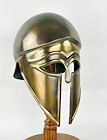
Corinthian Helmet – 8th century B.C.E.: Probably one of the most iconic war helmets of history, the Corinthian helm gives excellent, overall protection to the head whilst giving suitable allowances for vision, hearing and breathing without excessive obstruction.
Though it is a very practical helm, the Greeks made sure it was suitably stylized; the added eyebrows, stylized eyes and elongated faceplate portrays a noble, yet intimidating look.
1st to 4th century: Interesting Thought: There is some evidence that legionaries had their crests mounted longitudinally and centurions had them mounted transversely. Centurions may have worn the crests during battle to indicate rank, while legionaries may have worn them more ceremoniously.
Spangenhelm, 6th to 10th century: These types of helmets were usually a bit conical (pointy toward the top). They usually have cheek pieces and can be highly decorated, sometimes have face masks, and occasionally have chain mail aventails that protect the back of the neck.
 The Norman Mailer Helm – Hack-er Proof
The Norman Mailer Helm – Hack-er Proof
Nasal Helm/Norman Helm, 11th to 13th century: The height of their popularity is in the 11th-12th centuries. These helmets gradually replaced the spangenhelms because of their one piece skulls. They’re called nasal helms because of a piece of metal that extends over the nose.
Kettle Helm. Not to be confused with a cooking pot.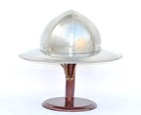
Kettle Helm, 11th century: The 11th century is when the “Iron Hat” was most popular, but variations of this type of helm have existed all the way into World War II. Many variations of these helmets exist, but all have wide metal brims, and most do not have any sort of face protection. They were NOT used for cooking the daily meals.
Cervelliere, 12-14th centuries: Excellent for protecting the top of the head from sword blades, it was worn over a chain coif and under a great helm, as extra protection.
The Great Helm, 12th to 14th centuries: Great helms covered the entire head. A great big cylinder of steel, with eye slits and (often) perforations near the mouth for your breathing enjoyment. These helms were originally flat-topped and evolved to a curved form to deflect blows. Great helms were typically worn over a padded hood, and sometimes a chain coif and cervelliere (the steel beanie, thingy)
Hounskulls, 14th century: They provided effective protection for the face and better ventilation, might have made you the butt of jokes from the other more oxygen challenged warriors. Hounskulls were basically tall bascinets with beaked visors that could be raised when not in combat. Slits in the visor allowed for vision, and tons of little holes around the beak provided air.
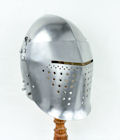 Bascinet. Used by infants? Nay, Infantry.
Bascinet. Used by infants? Nay, Infantry.
Bascinet, 14th century: Bascinet helms were typically open-faced. You could attach a “face guard” or movable visor. Bascinets usually were worn with chain mail aventails that protected the back of the neck and the throat.
Sallet, 15th century:. The sallet was a half-helm, really, a bascinet with a long, curved brim at the back to protect the neck and shoulders. Add the half-visor that protected the top half of the face, and you have a work of art.
Armet/close helm, 15th century: Armets have swiveling cheek plates, while close helms had bevors that pivoted upward and away from the face with the visor. Both helmets fully enclose the face, and are more fitted to the wearer’s head than many of the other helms from history.
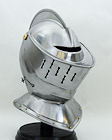 Not much use except for jousting.
Not much use except for jousting.
Frog Mouthed Helmet, 15th Century: The narrow visor and the jutting lower brim protected the jouster’s eyes. These helms included an elaborate web of straps inside that kept the steel from actually touching the knight’s head. This prevented the transfer of energy from lance to skull.
Burgonet, 16th century: Burgonets were similar to armets, but they had a characteristic ridge that ran along the top of the head, starting at the forehead and curling back like a crest. These helmets did not typically have face protection, but had long cheek pieces and a long, curved brim at the front. Sometimes a falling buffe was added to protect the face.
Get thee to the New World
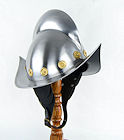 Morion, 16th-17th centuries: The Morion is best known as the conquistador helm. The helmet has the long, curving crest looping back from the forehead, although the Morion crest is often slightly larger. And they both have brims along the front (and sometimes the back). Morions can have cheek pieces, but typically do not. They rarely had any type of face protection.
Morion, 16th-17th centuries: The Morion is best known as the conquistador helm. The helmet has the long, curving crest looping back from the forehead, although the Morion crest is often slightly larger. And they both have brims along the front (and sometimes the back). Morions can have cheek pieces, but typically do not. They rarely had any type of face protection.


